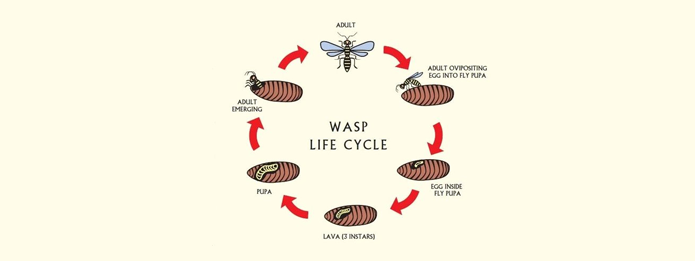
Wasps are insects with smooth bodies that can be up to 1.5 inches long similar to the size of a paperclip. Wrapped in bright, warning colours, wasps are easily identifiable. Known as Hymenoptera in the scientific community, they have around 30,000 identified species.
The life cycle of a wasp is an interesting phenomenon, and knowing this information may help you get rid of your wasp problem. Learn about the life, habits and behaviours of a wasp and if you need additional help, contact residential pest control in Cambridge.
Types of Wasps
There are two types of wasps: solitary and social. Solitary wasps make up most of the wasp species. These include:
- Great black
- Golden digger
- Grass-carrying
- Cicada killer
- Thread-waisted
There are only around 1,000 species of social wasps, with about 20 of those found in North America. These wasps are the kind that most people think about. They are yellow jackets, hornets, and paper wasps. Social wasps make the large nests that are easily identifiable.
Life Cycle
Wasp colonies may last from spring to autumn. The workers’ life span may last from 12-22 days, while the queen may live up to a year. The life cycle begins in the spring with the emerging of a fertilized queen wasp from hibernation. The queen will not use the same nest from the previous year. She will look for someplace new. Sometimes, she may build near the old nest. For social wasps, the queen makes a few cells to lay eggs that will become her first workers.
The nest is a wood mixture made with the queen’s saliva. The queen begins with a single stalk, called a petiole, with a hexagonal-shaped cell at the end. She will make about six more around the centre cell. She will cover each of these with a chemical to repel ants.
The queen lays an egg in each cell. After they hatch, she will feed them protein-enriched food from insects. The larvae seal themselves inside their cells and pupate to become adult wasps. These first wasps are female and will take over the nest building, rearing the young and finding food.
A wasp queen can lay between 200-300 eggs a day. She will then lay eggs that will turn into queen eggs and drones. Each nest could produce around 1000-1500 new queens. Once she lays these eggs, she is done for the season. A nest may reach its maximum size toward the end of summer. This is the reason why killing the queen is a must for preventing infestation.
After the babies have grown and left the nest, the workers cannot rely on the larvae’s food. They must look outside of the nest. When the winter temperatures come and food becomes scarce, the only wasps to survive are the new queens.
Wasp Predators
While wasps look for insects to use as food for the larvae, other insects and birds search out wasps for their sustenance. Predators of wasps include:
- Praying mantis
- Dragonflies
- Hoverflies
- Beetles
- Moths
- Starlings
- Magpies
Reptiles and amphibians also put wasps on their food list. Frogs, lizards, toads and salamanders will make a meal out of these stinging invaders.
Wasp as Pollinators
Wasps have their good points. They take care of pests that invade your vegetable and flower gardens. Being omnivores, wasps also use flowers and fruits to supplement their diet. Inadvertently, they become pollinators and transfer pollen from one flower to the next.
Fig wasps are pollinators that use the fig fruit as the nest to lay their eggs. Once they lay an egg, they take the pollen collected from a male fig flower and push it into the female flower. The wasp offspring uses the tissue from the new flower as it matures.
With winter approaching, most wasps will die off. However, with the warmer weather, the queens will emerge to start a new generation. Contact a residential pest control in Cambridge for wasp control and removal.